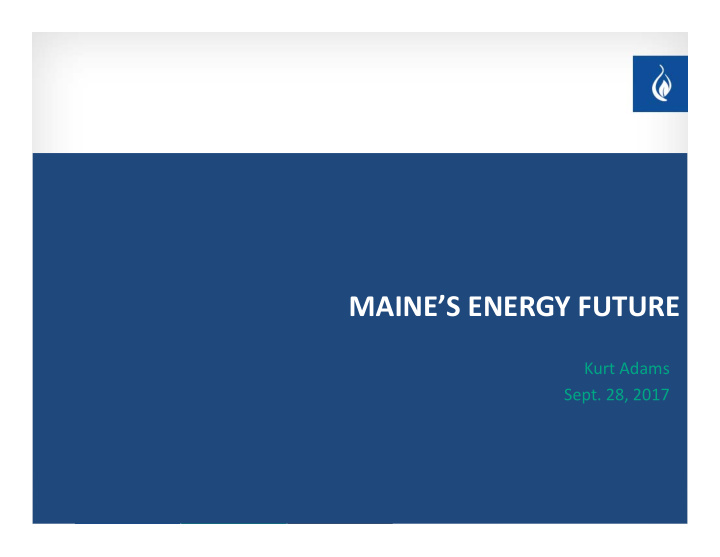



MAINE’S ENERGY FUTURE Kurt Adams Sept. 28, 2017 Confidential and Proprietary
Summit Utilities: Where We Are MAINE Customers: 3,000 Transmission Main Line: 68 miles Distribution Main Line: 163 miles COLORADO Customers: 21,300 Transmission Main Line: 6 miles Distribution Main Line: 1,252 miles MISSOURI Customers: 18,800 Transmission Main Line: 304 miles Distribution Main Line: 1,058 miles OKLAHOMA Customers: 12,900 T&D Main Line: 832 miles ARKANSAS Customers: 45,000 400 Employees T&D Main Line: 1,717 miles 100,000 Customers 5 States 2 Confidential and Proprietary
Natural Gas Can Power Maine’s Energy Future Natural Gas Can Expanding Natural Gas can lower consumer heating Strengthen Our costs 15 ‐ 25% over 10 years! Economy Source: internal modeling with data provided by the Governor’s Energy Office and the EPA Natural Gas Can Drive Our Expanding Natural Gas will lower CO2 emissions by over 300,000 tons per year! Environmental Priorities Confidential and Proprietary Source: internal modeling and data provided by ICF.
Natural Gas: Stable and Low Cost Gas Will Become Increasingly Cost Effective Source: Data provided by ICF Confidential and Proprietary
Natural Gas Costs Less Than Other Fuels Heating Value 60 Heating Costs in Maine Per MMBTU Compared to Other 50 Energy Sources 40 30 Natural gas costs 20 less to use than 10 other major home energy sources. 0 Natural Gas Heating Oil Wood Pellets Propane Electricity Natural Gas Heating Oil Wood Pellets Propane Electricity Source: http://maine.gov/energy/fuel_prices/index.shtml Confidential and Proprietary
Electrification is Less Efficient Than Gas Delivered to the Home Natural Gas Electricity Source: American Gas Association Confidential and Proprietary
Even with Heat Pumps….. Electric Heat Pump Performance Erodes in Cold Climates Cold ambient temps lower heat pump efficiency by 30 ‐ 50% (or more.) Source: Recent study by GTI Confidential and Proprietary
Natural Gas Can Drive our Environmental Priorities Particulate Emission Reductions are Key to Health Natural Gas resulted in virtually zero particulate emissions. That’s compared to 1.4 lbs/MMBTus resulting from an EPA Certified Woodstove . Confidential and Proprietary
Moving to Natural Gas has Enormous CO2 Reductions Natural Gas Emissions Compared to Other Fuels Sources Natural Gas releases fewer emissions compared to fuel alternatives. Confidential and Proprietary
The Economic Benefits Average savings of Of 50 percent of Maine Homes Using Fuel Oil Switching to Natural Gas Are 15 ‐ 25% Enormous over a 10 years. per year Source: internal modeling and data provided by ICF. Confidential and Proprietary
The Environmental Benefits of Gas Expansion in Maine Are Greater than Most Achievable Environmental Policies. 70 percent of Maine homes are heating with oil. If Imagine taking the we were to convert just 50 percent of the homes equivalent of heated with oil in Maine to natural gas we could 65,500 Cubic feet reduce carbon related emissions more than 300,000 metric tons a year. cars off the road in Maine. With natural gas we can! Source: internal modeling with data provided by the Governor’s Energy Office and the EPA Confidential and Proprietary
And Yet…Maine is Lagging Behind in Providing Natural Gas Access "Maine's natural gas consumption per capita is about half the national average. Only about 1 in 20 Maine households use natural gas as their primary heating fuel, in part because many areas of Maine lack natural gas distribution systems. ” – U.S. Energy Infrastructure Administration Confidential and Proprietary
An Agenda to Move Forward Confidential and Proprietary
01 Getting Cleaner Methane emissions per unit of gas produced have declined by 74% in U.S. distribution since 1990. Source: American Gas Association Confidential and Proprietary
02 Extending the Benefits of Natural Gas TIF Districts What Conversion Incentives ‐ Efficiency Maine Works in rebates to reduce the cost of converting Maine? to the highest efficiency appliances Strong relationship with our communities A statewide GIS mapping program for underground facilities Consistent gas policy Flexible growth regulation Confidential and Proprietary
03 Enhanced Emphasis on CHP Confidential and Proprietary
Recommend
More recommend